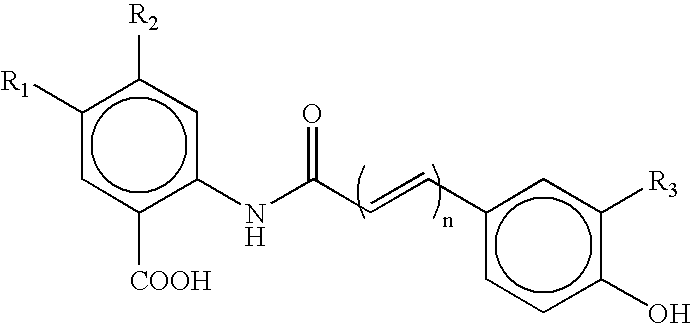Avenanthramide-containing compositions
a technology of avenanthramide and composition, which is applied in the field of pharmaceutical compositions, can solve the problems of colloidal oatmeal, undesirable residues on the skin and other surfaces, and inability to fully dissolve in water, and achieve the effects of affecting the acceptance of some consumers' products, and affecting the acceptance of some consumers
- Summary
- Abstract
- Description
- Claims
- Application Information
AI Technical Summary
Benefits of technology
Problems solved by technology
Method used
Image
Examples
example 1
Oat Extract Preparation Process
[0131]Two or three replicates for each method were processed and analysed.
[0132]METHOD. Oat groats (Variety Hinoat) were ground through a Willey Mill to pass through a 10 Mesh screen. Oatmeal at a mixing ratio of 1:4 (w / v) oatmeal:solvent was added to a stirred solution of 50% (v / v) aqueous ethanol at 40 C. The resulting mixture was stirred for 30 minutes and then cooled to room temperature. The mixture was then centrifuged at 2830 g for seven minutes and the supernatant drawn off. The pellet was re-suspended in fresh solvent and re-centrifuged. The supernatant was drawn off and the pellet re-suspended a third time in fresh solvent. All supernatants were combined and filtered through a course sintered glass filter.
[0133]To show the difference between the method (process) for producing an oat extract according to the present invention, which comprises the step of adjusting the pH of the extract to <4.0, and a method which does without pH adjustment, a c...
example 2
[0151]METHOD Oat groats (Variety AC Ernie) were ground through a Willey Mill to pass through a 10 Mesh screen seive. Oatmeal (1.5 kg) was added to a stirred solution of 50% (v / v) aqueous ethanol (6000 ml) at 40° C. The resulting mixture was stirred for 30 minutes and then cooled to room temperature. The mixture was then centrifuged at 2830 g for seven minutes and the supernatant drawn off. The pellet was re-suspended in fresh solvent (3000 ml) and re-centrifuged. The supernatant was drawn-off and the pellet re-suspended a third time in fresh solvent (3000 ml). All supernatants were combined and filtered through a coarse sintered glass filter. The pH of the extract was adjusted to pH 3.5 with hydrochloric acid (1M) and ethanol added (−1%) to clarify the solution. The pale yellow extract was passed through a 0.45 μm filter (Gelman; Supor DCF) and made up to 12000 ml before ultrafiltration.
[0152]The extract was ultrafiltered at ambient temperature through a...
example 3
Anti-Erythema Testing in Human Subjects
[0156]Skin tests were carried out on healthy male and female volunteers
[0157]a. 18 to 60 years of age;
[0158]b. Fair-skinned with skin types I-III, determined by the following guidelines:
[0159]I Always burns easily; never tans (sensitive)
[0160]II Always burns easily; tans minimally (sensitive)
[0161]III Burns moderately; tans gradually (normal)
[0162]IV Burns minimally; always tans well (normal)
[0163]V Rarely burns; tans profusely (insensitive)
[0164]VI Never burns; deeply pigmented (insensitive)
[0165]The following exclusion criteria were followed:
[0166]a. Subjects with a history of abnormal response to sunlight;
[0167]b. Subjects exhibiting current sunburn, suntan, or even skin tone which might be confused with a reaction from the test material or which might interfere with evaluation of the results of the test;
[0168]c. Pregnant or lactating females;
[0169]d. Subjects taking medication which might produce an abnormal response to sunlight or interfer...
PUM
| Property | Measurement | Unit |
|---|---|---|
| volume | aaaaa | aaaaa |
| temperature | aaaaa | aaaaa |
| molecular weight | aaaaa | aaaaa |
Abstract
Description
Claims
Application Information
 Login to View More
Login to View More - R&D
- Intellectual Property
- Life Sciences
- Materials
- Tech Scout
- Unparalleled Data Quality
- Higher Quality Content
- 60% Fewer Hallucinations
Browse by: Latest US Patents, China's latest patents, Technical Efficacy Thesaurus, Application Domain, Technology Topic, Popular Technical Reports.
© 2025 PatSnap. All rights reserved.Legal|Privacy policy|Modern Slavery Act Transparency Statement|Sitemap|About US| Contact US: help@patsnap.com

